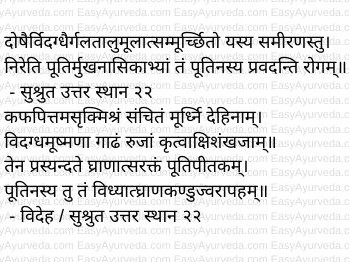Putinasa (Pootinasa) – Causes, Symptoms, Treatment
By Dr Raghuram Y.S. MD (Ay) & Dr Manasa, B.A.M.S
Putinasa is a nasal disorder. It is called so because of foul smelling discharges occurring from the nose of the patient.
Puti – foul smelling
Nasa – nose
Read – Deepti Roga Nasal Disorder – Causes, Symptoms, Ayurvedic Treatment
Table of Contents
Pathogenesis, Symptoms of Pootinasa
The vata located in the root of throat and palate on getting afflicted, enveloped and admixed by the vitiated doshas therein would produce a nasal disorder called putinasa. In this condition, the vayu along with the doshas comes out of the nose and gets discharged with foul smell. This is also called as putinasya.
Read – Nose Bleed: Ayurvedic Understanding, Treatment
Symptoms
Foul smelling discharge of doshas from the nose is the only predominant symptom of this disease.
Pathogenesis and symptoms as explained by Master Videha (Su.Ut.22) –
Vitiated kapha, pitta and rakta get accumulated in the head of the patient. Due to the impact of the heat in the head the doshas get blocked and thicken the discharges. Later these doshas produce severe pain in the head and temples. The patient will also have yellow colored, blood mixed and foul smelling discharge from his nose (mucopurulent discharges). He will also have bad breath. This condition is called as putinasya. In this condition the patient will experience itching in his nose and also will have fever.
Sanskrit Verses

Treatment of Putinasa nasal disorder
Putinasa is treated on the lines of treating Pinasa nasal disorder.
Specific treatments
Shadbindu Ghrta Nasya – Nasal drops should be instilled with the ghee prepared using the below mentioned herbs –
- Bhringaraja – Eclipta alba
- Clove
- Licorice
- Kushta – Saussurea lappa
- Ginger
Alternatively the powder of these ingredients mentioned above shall be mixed in ghee and instilled in the nose of the patient.
This cures pinasa and headaches of various kinds.
Shad bindu means 6 drops. Since this ghee is used in the dose of 6 drops the formulation is called as Shadbindu Ghrta.
Read – How To Do Ayurvedic Nasya At Home? Types, Precautions
Vyaghri Taila Nasya – The oil prepared with the below mentioned herbs should be instilled in the nostrils of the patient in the form of drops –
- Vyaghri – Solanum xanthocarpum
- Danti bija – seeds of Baliospermum montanum
- Vacha – Acorus calamus
- Shigru – Moringa oleifera
- Trikatu – Piper longum, black pepper and ginger
- Rock salt
Pinasokta Avapidana – From the formulations used to treat pinasa in the form of avapidana nasya (juices of the herbs are pressed as drops into the nostrils of the patient), oil should be processed by adding mustard oil and urine of cow. These oils should be used for nasal instillation as drops. They cure putinasa and the bad smell in the nose and breathe.
Kantakari Swarasa Nasya – Fruits of Kantakari – Solanum xanthocarpum should be heated on fire and its juice extracted. This juice should be used as drops in putinasa. Alternatively the juice of Kantakari should be extracted by heating them in putapaka method (concealed heating).
Probable Modern Comparison
Putinasa can be closely compared to ozaena, a form of chronic atrophic rhinitis. Many experts have compared putinasa to atrophic rhinitis.
Click to Consult Dr Raghuram Y.S. MD (Ayu)









